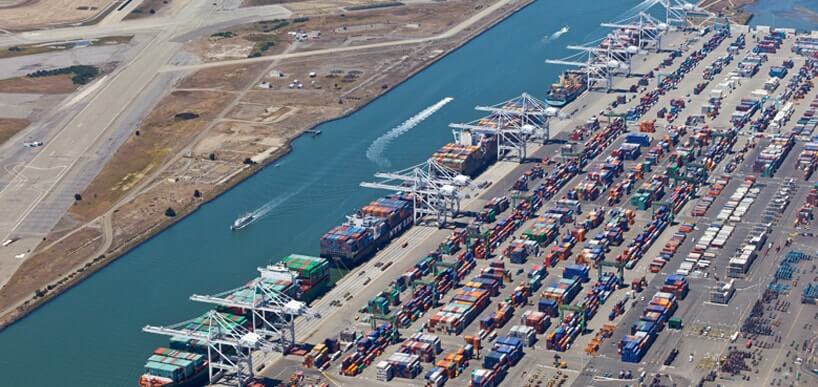Imports and exports have rebounded at the Port of Oakland which expects a “strong fourth quarter for 2020.”
In an interview with AJOT, Bryan Brandes, the new maritime director for the Port of Oakland, also projects: “The first quarter of 2021 also looks to be a strong quarter.”
A recent Pacific Maritime Association report warned that British Columbia ports could take away up to 45% of the intermodal business from the Asia ocean carrier trade of U.S. West Coast ports dependent on U.S. Midwest customers.
The PMA report cited high rail rates charged by the Burlington Northern Santa Fe (BNSF) and the Union Pacific (UP) totaling $400 per container between U.S. West Coast ports and Chicago. This was the most significant of several factors that could cause the U.S. ports to lose their Asia trade to lower cost freight charges between the U.S. Midwest and the British Columbia ports of Prince Rupert and Vancouver.
“As the first ports of call from Asia, the Ports of L.A. and Long Beach have the most rail requirements to transport import containers to Midwest destinations. We are the second port of call and so our rail business is much smaller. We are, however, looking to expand rail connections to Salt Lake and Denver.”

Focusing on Exports
Brandes said that Port of Oakland is fortunate to have a market that is 50% import and 50% export and is hopeful about its export market potential: “We are the second port of call and so exporters can load export containers in Oakland and have a faster transit time than from L.A. and Long Beach to Asia. Also, we are right next to the San Joaquin Valley, a major U.S. agricultural center and source of agricultural exports which are all trucked and not rail dependent. We are looking to expand our export market by attracting agricultural exports from the Midwest and from the Gulf.”
To enhance its rail business, the Port will be supported by three near-dock transloading facilities. The facilities are:
- Cool Port. Cool Port is a 280,000-square-foot temperature-controlled distribution center. It was opened by Lineage Logistics and Dreisbach Enterprises. The facility has the capability of shipping 1 million tons of beef and pork annually. According to the Port of Oakland website: “Meat shipments from as far away as the Midwest will go directly into Cool Port by rail. Cargo will whisk across Cool Port’s dock into 40-foot refrigerated containers. From there, shipments can be drayed across the street to the Port’s marine terminals for export.”
- Seaport Logistics Facility. The 460,000 square foot facility is located on a 27-acre site. The $52 million project allows containerized cargo to be quickly transferred from ships to trucks or rail which it expects to increase the volume of international shipments moving through Oakland. The Seaport Logistics Complex is right next to the Port’s new $100 million rail yard. Construction is projected to be completed by the end of 2020.
- Transload facility. A third rail transload facility for dry goods is also planned.
Blank Sailings
Along with other ports, Oakland has suffered from uncertainties related to recent ocean carrier arrivals and departures due to cancelled or “blank sailings.” These were instituted by the carriers in response to reduced demand in March caused by the Covid pandemic, Brandes said.
Peter Friedmann, executive director, Agriculture Transportation Coalition representing agricultural exporters has cited these schedule changes as a disruptive force on his members.
Brandes says, “There isn’t a lot of control that we have over carrier schedules, but we can facilitate communication between the parties and we can publicize those schedule changes on our website to help alert shippers with the latest information.”
Improving Truck & Rail Traffic
Brandes said that there are three improvements at the Port that should improve the flow of truck and rail traffic reducing delays: They are:
- The 7th Street grade separation. This will improve roadway flows for trucks and rail. The project will elevate the intersection between Maritime and 7th Streets, reconstruct an ailing railroad underpass and construct a new rail spur. The project is anticipated to be completed in 2023 and cost nearly $600 million.
- The Freight Intelligent Transportation System (FITS). This system will provide electronic updates and wait times at terminals that will be available to drivers on mobile phone apps. The project will also enhance port security monitoring and accident and incident warnings through improved data exchange. This upgrade should be completed by 2021.
- Night-gate capacity. Capacity at terminals is expanding and will allow for more daytime deliveries to be shifted to nighttime deliveries with the cumulative effect of reducing truck traffic at the Port.
Accommodating 18,000 TEU Ships
The Port plans to handle mega 18,000 TEU ships and larger on a regular basis. To do this, all three terminals at the Port will need taller cranes.
In the case of the Oakland International Container Terminal (OICT), operated by Stevedoring Services of America (SSA), three new ship-to-shore cranes will be arriving from the Chinese crane maker, ZPMC, after Thanksgiving, Brandes said.
OICT can currently handle one 18,000 TEU at a time. The vessel can only depart by being backed out of the terminal twice per day under favorable tides. To facilitate more than one 18,000 TEU ship arrival at OICT there are plans to expand the turning basin adjoining OICT, so that vessels can be turned about and will not have to back out:
“The U.S. Army Corps of Engineers is currently working on a feasibility study for the widening of the turning basin. That study is expected to be completed within the next two years after which an appropriation will be necessary for the dredging. We hope the work will begin sometime around 2026.”

